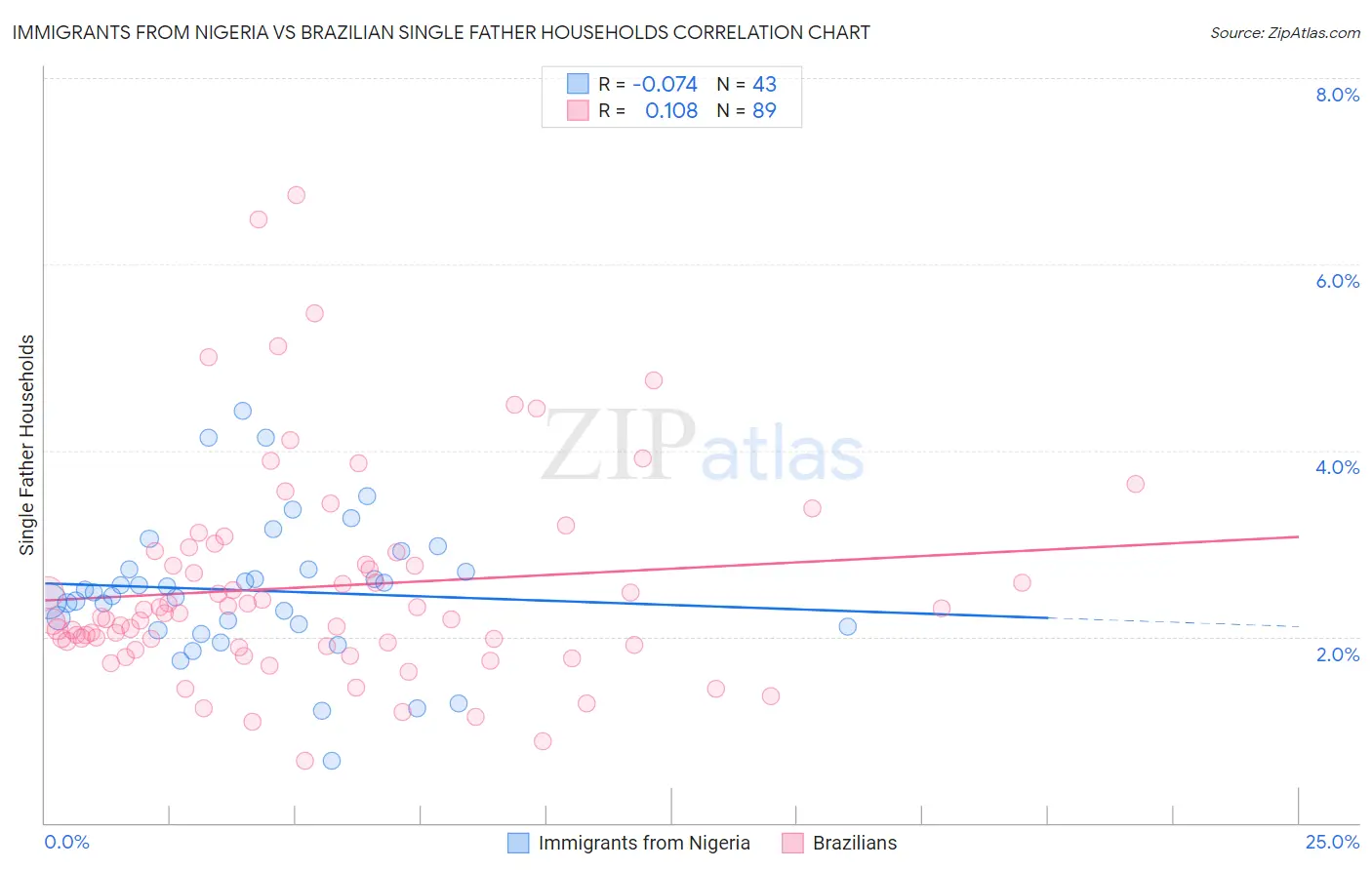Immigrants from Nigeria vs Brazilian Single Father Households
COMPARE
Immigrants from Nigeria
Brazilian
Single Father Households
Single Father Households Comparison
Immigrants from Nigeria
Brazilians
2.4%
SINGLE FATHER HOUSEHOLDS
18.7/ 100
METRIC RATING
211th/ 347
METRIC RANK
2.2%
SINGLE FATHER HOUSEHOLDS
92.8/ 100
METRIC RATING
139th/ 347
METRIC RANK
Immigrants from Nigeria vs Brazilian Single Father Households Correlation Chart
The statistical analysis conducted on geographies consisting of 282,146,516 people shows a slight negative correlation between the proportion of Immigrants from Nigeria and percentage of single father households in the United States with a correlation coefficient (R) of -0.074 and weighted average of 2.4%. Similarly, the statistical analysis conducted on geographies consisting of 321,679,292 people shows a poor positive correlation between the proportion of Brazilians and percentage of single father households in the United States with a correlation coefficient (R) of 0.108 and weighted average of 2.2%, a difference of 7.7%.

Single Father Households Correlation Summary
| Measurement | Immigrants from Nigeria | Brazilian |
| Minimum | 0.66% | 0.67% |
| Maximum | 4.4% | 6.7% |
| Range | 3.8% | 6.1% |
| Mean | 2.5% | 2.5% |
| Median | 2.5% | 2.2% |
| Interquartile 25% (IQ1) | 2.1% | 1.9% |
| Interquartile 75% (IQ3) | 2.7% | 2.9% |
| Interquartile Range (IQR) | 0.62% | 1.0% |
| Standard Deviation (Sample) | 0.75% | 1.1% |
| Standard Deviation (Population) | 0.74% | 1.1% |
Similar Demographics by Single Father Households
Demographics Similar to Immigrants from Nigeria by Single Father Households
In terms of single father households, the demographic groups most similar to Immigrants from Nigeria are Immigrants from Costa Rica (2.4%, a difference of 0.050%), Finnish (2.4%, a difference of 0.050%), Immigrants from Peru (2.4%, a difference of 0.060%), Immigrants from Kenya (2.4%, a difference of 0.18%), and Norwegian (2.4%, a difference of 0.20%).
| Demographics | Rating | Rank | Single Father Households |
| Ecuadorians | 24.5 /100 | #204 | Fair 2.4% |
| Immigrants | Afghanistan | 24.2 /100 | #205 | Fair 2.4% |
| Koreans | 24.1 /100 | #206 | Fair 2.4% |
| Whites/Caucasians | 22.6 /100 | #207 | Fair 2.4% |
| Immigrants | Kenya | 20.3 /100 | #208 | Fair 2.4% |
| Immigrants | Peru | 19.3 /100 | #209 | Poor 2.4% |
| Immigrants | Costa Rica | 19.2 /100 | #210 | Poor 2.4% |
| Immigrants | Nigeria | 18.7 /100 | #211 | Poor 2.4% |
| Finns | 18.3 /100 | #212 | Poor 2.4% |
| Norwegians | 17.1 /100 | #213 | Poor 2.4% |
| Ethiopians | 16.6 /100 | #214 | Poor 2.4% |
| Immigrants | South Eastern Asia | 15.9 /100 | #215 | Poor 2.4% |
| Immigrants | Ecuador | 14.9 /100 | #216 | Poor 2.4% |
| Dutch | 14.3 /100 | #217 | Poor 2.4% |
| Immigrants | Ethiopia | 13.4 /100 | #218 | Poor 2.4% |
Demographics Similar to Brazilians by Single Father Households
In terms of single father households, the demographic groups most similar to Brazilians are British (2.2%, a difference of 0.010%), Laotian (2.2%, a difference of 0.090%), Luxembourger (2.2%, a difference of 0.13%), Immigrants from Nepal (2.2%, a difference of 0.19%), and West Indian (2.2%, a difference of 0.42%).
| Demographics | Rating | Rank | Single Father Households |
| Poles | 96.5 /100 | #132 | Exceptional 2.2% |
| Taiwanese | 96.3 /100 | #133 | Exceptional 2.2% |
| Zimbabweans | 95.1 /100 | #134 | Exceptional 2.2% |
| Syrians | 94.8 /100 | #135 | Exceptional 2.2% |
| Chileans | 94.5 /100 | #136 | Exceptional 2.2% |
| Austrians | 94.2 /100 | #137 | Exceptional 2.2% |
| West Indians | 94.1 /100 | #138 | Exceptional 2.2% |
| Brazilians | 92.8 /100 | #139 | Exceptional 2.2% |
| British | 92.8 /100 | #140 | Exceptional 2.2% |
| Laotians | 92.5 /100 | #141 | Exceptional 2.2% |
| Luxembourgers | 92.3 /100 | #142 | Exceptional 2.2% |
| Immigrants | Nepal | 92.1 /100 | #143 | Exceptional 2.2% |
| Slovaks | 90.7 /100 | #144 | Exceptional 2.2% |
| Immigrants | Zimbabwe | 90.2 /100 | #145 | Exceptional 2.2% |
| Northern Europeans | 89.8 /100 | #146 | Excellent 2.2% |